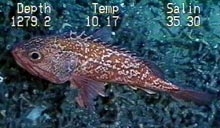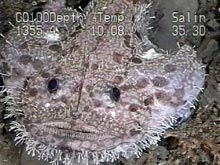
Blackbelly rosefish photographed on Lophelia coral banks located off Cape Lookout, NC. Click image for larger view.
North Carolina Reef Systems
Ann Marie D. Necaise
Steve W. Ross, PhD
Andrea Quattrini
North Carolina National Estuarine Research Reserve
Most people associate coral reef systems with tropical islands and warm, shallow waters. It may be surprising to learn that two unique types of reef systems exist off the coast of North Carolina. One serves as an important habitat for several species of commercially and recreationally important fishes, while the other represents a rare, deep-water coral reef. The first is found on the shelf edge, approximately 75 miles offshore, and we refer to this system of reefs as the “Outer Shelf Reefs." The second reef system is located further offshore (50 to 100 mi) and is known as the “Lophelia Coral Banks," named after the coral species that makes up this system of reefs. Each of these systems is important to a diverse assortment of fishes and invertebrates.
The Outer Shelf Reefs
The Outer Shelf Reefs are found at depths between 50-200 m along the edge of the continental shelf. They serve as oases for fish and invertebrates in the otherwise barren landscape of the open ocean, providing protection from predators and abundant food resources. Remarkably, in only a few dives on this reef system to date, scientists have discovered five species of fish not previously reported from the United States, and nine species not previously reported from North Carolina.
One unusual species found on these reefs was the red lionfish (Pterois volitans). The red lionfish is native to Pacific waters, ranging from southern Japan to Australia and throughout Indonesia, Micronesia and French Polynesia. Within recent years, however, sightings of this species have occurred in the western Atlantic from Bermuda to New York. During the 2002 "Islands in the Stream" Ocean Explorer mission, our scientists observed a total of 14 red lionfish on the Outer Shelf Reefs. These observations were made over a relatively small area, suggesting that actual numbers may be higher than those observed, and that the species may be establishing itself in North Carolina waters.

Non-native red lionfish photographed over the Outer Shelf Reefs off Cape Fear, NC. Click image for larger view.
Species just as colorful and diverse as those found on tropical reefs, such as the short bigeye (Pristigenys alta), bank butterfly fish (Chaetodon aya), blue angelfish (Holacanthus bermudensis), sharpnose puffer (Canthigaster rostrata), red barbier (Hemanthias vivanus) and spinycheek soldierfish (Corniger spinosus) are often sighted here. The larvae and juveniles of many of these species become entrained in the Gulf Stream over reef systems further south, and are carried northward to habitats off North Carolina.
Cryptic fishes -- those with skin color and patterns that blend into the background environment -- are also found in and around the Outer Shelf Reefs. Species such as the Gulf Stream flounder (Citharichthys arctifrons), offshore lizardfish (Synodus poeyi), diamond lizardfish (Synodus synodus) and American sand lance (Ammodytes americanus) bury themselves in the sediment surrounding these reefs. The mottled pigment patterns of their skin blend in with the sandy bottom, making detection by predators difficult.
Since large aggregations of fish are associated with the Outer Shelf Reefs, this area is well known to commercial and recreational fishermen. Commercially and recreationally important species, such as gag (Mycteroperca microlepis), scamp (Mycteroperca phenax), yellowedge grouper (Epinephelus flavolimbatus), snowy grouper (Epinephelus niveatus), grunts (Haemulon aurolineatum and H. striatum) and snappers (Lutjanidae) utilize these habitats.
Several species within this reef system are severely overfished or in danger of being so. Hence, fisheries resource managers are considering designating portions of the Outer Shelf Reef habitats as marine protected areas, which could help rebuild stocks. Part of the 2003 cruise mission is to determine species composition and abundance within these habitats, data which may ultimately help marine resource managers prioritize areas for protection.
Lophelia Coral Banks
The Lophelia Coral Banks are located in water depths greater than 300 m, past the edge of the continental shelf. Surprisingly, these coral reefs thrive in complete darkness and temperatures averaging 10° C (50° F), waters much colder than those of tropical reef systems. Additionally, the Lophelia corals grow without the aid of symbiotic algae, resulting in an exceptionally slow growth rate. Nevertheless, over thousands of years, they can attain massive sizes, rising 10 m or more over the bottom of the ocean and spreading out for hundreds of meters. Like the Outer Shelf Reef systems, these coral banks provide important habitat in the featureless environment of the open ocean bottom.
The Lophelia Coral Banks located off Cape Lookout, NC, may be the northernmost deep-water coral banks along the U.S. East Coast. Due to their depth and the fragile nature of coral habitats, traditional research sampling methods cannot be used in these areas. Because conventional sampling gear, such as otter trawls or benthic dredges, are too destructive and damaging to use in slow-growing coral systems, these habitats and their fauna have been poorly studied until recently. Through the use of submersibles, however, observations and selective samples can now be taken without causing unnecessary damage to the environment. As a result, recent research cruises in this area, including the 2002 Islands in the Stream Ocean Explorer mission, have provided valuable information about species diversity and abundance as well as animal behavior in these deep-water habitats.
These coral banks are populated by a unique combination of deep-water reef fishes, as well as shelf, midwater and deep ocean fishes. Unusual fishes, such as the longnose batfish (Ogocephalus corniger), Atlantic batfish (Dibranchus atlanticus), conger eel (Conger oceanicus) and skates (Breviraja plutonia and B. spinosa) are commonly found in this habitat. Deep- sea fishes, such as the blackbelly rosefish (Helicolenus dactylopterus), longfin hake (Phycis chesteri), spotted codling (Urophycis regia), greeneye (Chlorophthalmus agassizi) and deep-water scorpionfish (Setarches guentheri) are also collected in large numbers in and around this habitat. Our scientists have also observed bright red alphonsins (Beryx splendens) and large wreckfish (Polyprion americanus) moving in and around the coral. Midwater fishes, such as the lanternfishes (Myctophidae) and hatchetfish (Sternoptyx diaphana), migrate daily between this bottom habitat and the upper layers of the ocean, providing an interesting link between surface and deep-sea communities.
With this mission, exploration of the unique reef systems found off North Carolina will continue where they left off last year. The possibility of discovering new species and range extensions exists with each visit to these areas, as does the opportunity to gain new information about community structure, feeding relationships and reproduction. The information obtained through sampling and observation while at sea this August, as well as the follow-up studies conducted back in the laboratory, will continue to add to our understanding of these unique habitats.























